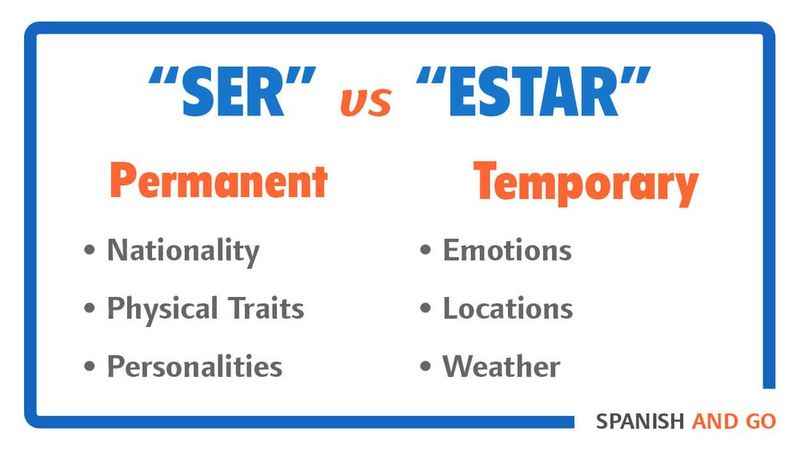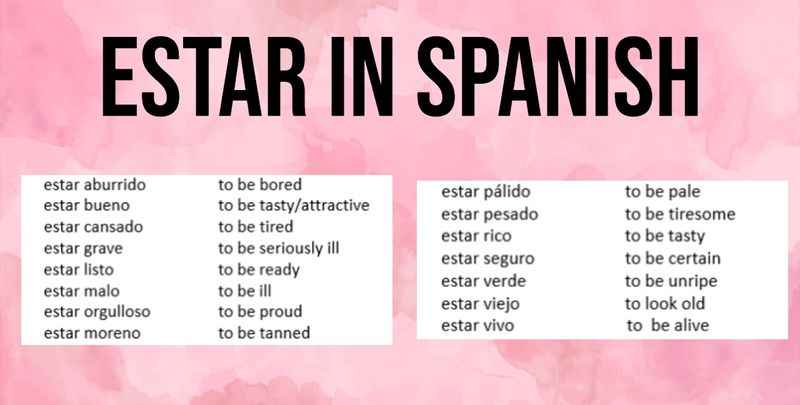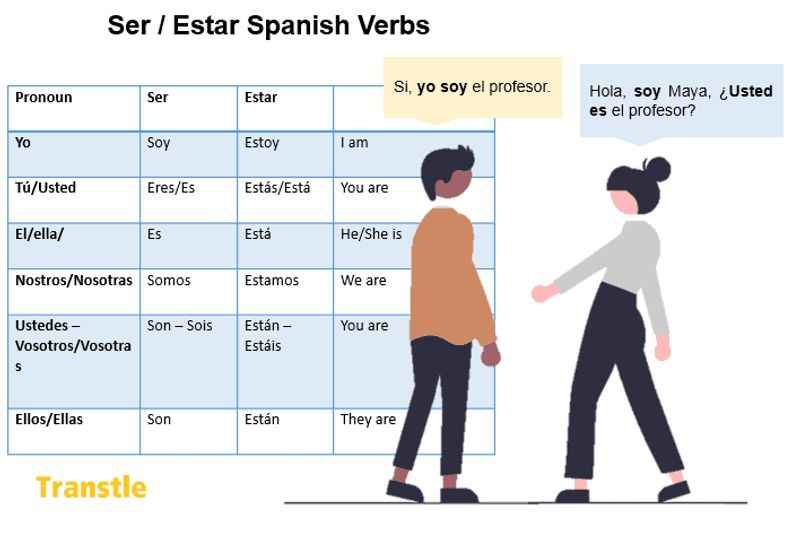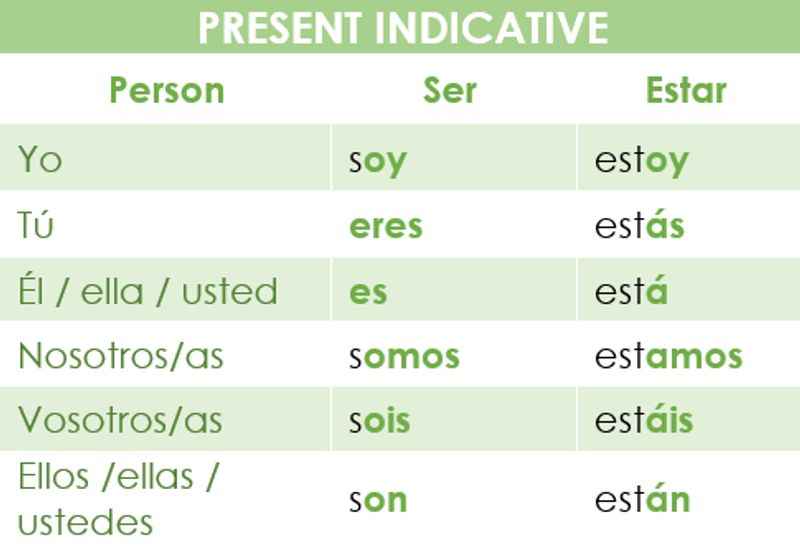SER or ESTAR? All You Need to Know Before Travel to Spain | 2024 (with Examples)

“To be, or not to be, that is the question” (Hamlet) is probably one of William Shakespeare’s most widely known quotations.
Turns out, the same question is posed in Spanish, too - Ser or Estar? Well, SER and ESTAR are both different translations of the verb ‘to be’.
Confusing, right? You are certainly not alone in your confusion. Indeed, SER and ESTAR have been making students learning Spanish scratch their chins in thought for hundreds of years. It is one of the more difficult aspects of Spanish grammar in an otherwise (relatively) straightforward language.
The reason for this is that it has different meanings in different languages. It is quite a puzzling thing to ponder since the use of either SER or ESTAR can change the meaning of what you are saying completely.
However, we are here to attempt to ease your confused minds by giving you an explanation of SER and ESTAR, telling you when you should use them, and how.
SER and ESTAR: The Misconceptions

There are a few myths and misconceptions floating around regarding the use of SER and ESTAR. The main myth that absolutely must be addressed is this: “SER is permanent and ESTAR is temporary”.
Whilst it is generally considered to be acceptable as a beginner's guide, it is not entirely true. The truth is that SER is not always permanent, and ESTAR is not always temporary. Believing them to be hard and fast rules can be very confusing, especially for beginners in the language.
If this is something that you have been taught before, we recommend that you remember there are plenty of exceptions and that this rule cannot be taken at face value. We will explain to you exactly how to use it properly.
When Spanish is taught in school or language classes, tutors and teachers alike often find that exposing students to very technical concepts of grammar is unsuccessful. This is because it can be very difficult to grasp and takes the fun away from language learning.
In order to understand SER and ESTAR, it is very important to be able to grasp the differences between an adjective, verb, and noun. As a Spanish learner, you should be able to distinguish one from the other.
When SER or ESTAR have exclusive meanings, this simply means that there are times when only one of them can be used correctly in a context. When it is shared meaning, both of them are correct but may mean different things. This means that in order to say the correct word you must figure out first what you want to convey.
Using SER Exclusively

Now that we have cleared up some misconceptions and myths about the use of SER and ESTAR, we can focus our attention on teaching you the rules. The first of these rules is about how to use SER and when it must be used. The use of SER as an exclusive means that it must be used for the sentence to be correct. Using ESTAR in its place would not work.
SER is used whenever there is a noun. What we mean by this is that wherever the verb “to be” is followed by a noun then SER must be used.
To use this correctly, you should of course be familiar with the concept of a noun and be able to identify one. In its most simple form, a noun is a naming word. To explain further, nouns are used to identify objects, things, people, places, and even ideas. For example, ‘chair’ is a noun because it is an object. More specifically, it is a concrete noun and part of the ‘common nouns’ group.
Another example of a noun is the proper noun. These relate to the individual names of things, people, and places. ‘America’ is a proper noun, as is ‘Beyonce’. Both of these types of nouns should use SER.
More Rules
Even the more ‘confusing’ nouns that can be harder to identify such as abstract nouns (‘honesty’, ‘love’, ‘wisdom’, ‘friendship’) and compound nouns (‘mother-in-law’, ‘snowflake’, ‘somewhere’, ‘upstream’) still need SER in order for form a correct sentence.
Every time you see these nouns after the verb “to be” you must use SER. This must be used even if there are also other words in the middle of the sentence and in between. For example, having adjectives, articles, and adverbs can seem confusing, but the rule of SER still needs to occur.
Let us show you an example. Perhaps someone has asked you “Who is your favorite singer?” and you would like to tell them that your favorite singer is Beyonce. In Spanish you would say and write it like this:
Beyonce es mi cantante favorita.
Get it? Because Beyonce is a noun, and the question asked is a ‘What’ or ‘Who’, then the verb is always SER. Let’s look at one more example before we move on. Imagine someone points at your chair and asks “What is this?”. You will answer and say:
Esta es mi silla.
You were asked a ‘What’ question, and of course, ‘chair’ is a noun. Therefore, the verb SER must be used.
It is as simple as that! Easier than you thought, right? If you still feel a little confused just take your time and read back through the section again, perhaps writing down some examples for yourself. Next, we need to explore when ESTAR must be used exclusively.
Using ESTAR Exclusively

ESTAR is different from SER when it is used exclusively in that it is used only when referring to the location of something or someone. By this, we mean that ESTAR is used alongside the preposition of ‘en’ and then followed by a noun that names a place.
If you get asked a question beginning with the word ‘Where’ then you can assume that the verb for ‘to be’ that you must use is ESTAR. To better understand this, you should see an example.
If someone asks you the question “Where is Isobel?” you can answer with the following:
Isobel está en el jardín.
Can you see here that you have been asked a ‘where’ question, and the answer involves answering them and telling them that Isobel is in the garden (a place name noun)?
It is followed by ‘en’ which is the preposition, and then ‘el jardín’ which is the noun. Let’s see another example. Someone may ask you ‘Where is the coffee?’. You can reply to this:
El café está en la cocina.
Notice that you were asked a ‘Where’ question, and so, to answer it you used ESTAR followed by the preposition ‘en’ and then the place name noun ‘la cocina.’
Exceptions to the Rule of ESTAR
However, there is a slight exception to this rule. It is very important to understand that there is a difference between answering where something or someone is and answering where someone or something is from.
For example, if you are asking where a person is from, then you would not be able to use ESTAR. As well as this, if you are asking someone where a concert is going to take place, then ESTAR cannot be used. In both these cases, SER needs to be used instead as it means “To be from” and “To take place” in these contexts. Let us show you an example just so you can be sure:
If someone asks you “Where are you from?”, because the verb you will be using is “to be from”, you must use SER. In this case, if you are from the US, your answer would be:
Soy de los Estados Unidos.
Let’s try another example. If someone asks “Where is the concert being held?” you can answer with this:
El concierto es en el estadio.
As you can see, even though the question is phrased with a ‘Where’ at the beginning, because the subject of the question is regarding ‘to be from’ and ‘to take place’ then SER needs to be used instead of ESTAR.
We know this seems confusing, but it is a simple rule that can be memorized easily. Just keep in mind that if someone asks you questions regarding where someone or something is from, or where something is going to be held, then you should use SER.
What About Verbal Nouns?

Verbal nouns, also known as gerunds, can be a confusing concept to grasp, especially when you are learning about them in another language. English speakers will know that a gerund is a verb that ends with the suffix ‘-ing’, such as ‘dancing’, ‘singing’, ‘sleeping’, and ‘running’.
These are all verbs (doing/ action words), but the inclusion of the ‘-ing’ suffix turns them into a noun. In Spanish, rather than adding ‘-ing’, the suffixes added are ‘-endo’ and ‘-ando’. This means that instead of ‘dancing’, the Spanish version would be ‘bailando’. This is because ‘bailar’ is ‘dance’, and the suffix added is ‘-ando’, meaning you drop the ‘ar’ on the verb and add the new ending. Get it?
In this case, we would use the verb “to be” along with the verbal noun (gerund) as a means of describing extended actions. If they are in the present tense, then that means that the action is happening there and then at that moment in time (i.e. when the person is asking the question or answering it).
If the question is asked in another tense (present or future) then you can use “they are” or “they were” doing something during a certain time frame. In any of these structures, ESTAR is always used.
Some Examples...
To demonstrate this, you should see an example. If someone asked “What is Lisa doing?”, you could reply:
Lisa está bailando.
Notice how they have asked what Lisa is doing at this moment. The reply uses ESTAR followed by the gerund (verbal noun) of ‘bailando’. Let us show you a second example to ensure you fully understand. You may ask “What are you doing?” and someone could reply:
Estoy yendo a la escuela.
The person is going to school, and so they have used ESTAR followed by the gerund ‘yendo’ and then the place they are going. This is a good example but this sentence structure is uncommon in Spanish.
You would be far more likely to hear "me voy a la escuela". Check out our article on how to learn Spanish for free if your aim is to learn more about Spanish grammar.
To confirm, if you ever get asked or ask someone else “What are you doing?” or “What are they doing?”, or any other questions that try to establish where someone is or what they are doing at that particular time, then the answer will include ESTAR.
SER or ESTAR: Shared Uses

By now, you will have an idea of when SER and ESTAR must be used exclusively. However, there are also instances where SER and ESTAR may have shared uses. By this, we mean that there may be some instances where both SER and ESTAR can be used and make sense.
One of these instances is when there is an adjective involved, such as when an adjective comes after the verb “to be''. This can get quite confusing, so we are going to break it down for you.
Adjectives
First, let’s establish what exactly an adjective is. Adjectives are describing words that can be used to describe things, objects, places, people, and ideas. They can also be used for clarity when trying to establish and distinguish.
The adjective is usually a reference to the visual presentation of the person, object, place, thing, or idea. Of course, as we now know, all of these things are nouns. An adjective may also be used in reference to the purpose of the noun or the origin of it.
To better understand this, an example would be helpful:
- I am sitting in the green chair.
- She is a great singer.
- She is in sunny Barcelona.
You can see that we have highlighted the adjectives here. Most adjectives can be used with either SER or ESTAR but to different effects. The verb you should be using will depend on the meaning of the sentence you wish to say.
Look below for the translations of some of the sentences above with the verb and adjective highlighted:
- Estoy sentado en la silla verde. (This sentence uses ESTAR)
- Ella es una gran cantante. (This sentence uses SER)
- Ella está en la soleada Barcelona. (This sentence uses ESTAR)
Some more examples...
A great way of remembering this is by looking at it as characteristics __and someone's personality versus conditions. Characteristics are a way of describing and distinguishing something. For example, “She is a great singer” can be used to distinguish a person from a ‘bad’ singer. Likewise, you could say “He is a tall man” (El es un hombre alto) as a way of distinguishing a man in a crowd.
Characteristic adjectives can differentiate nouns from each other and are essentially a description of the noun.
These include personality traits and a person's profession. However, these do not always describe a permanent condition as things can change. For example, that great singer may not always have been great! And someone may not always have been a happy person. In any case, all characteristic adjectives are used alongside SER.
The other type, as we stated above, is condition adjectives. These are often used to describe the condition something is in or how someone is feeling.
They are often related to the context and situation. You may have been taught that ESTAR is used to describe temporary states, but look at this sentence: Ella está muerta. This means "she is dead" - sounds permanent, right? But ESTAR is used, as it describes her state or condition.
When we told you that someone was in sunny Barcelona (Ella está en la soleada Barcelona) we were telling you about the condition of Barcelona at that time. The condition was sunny. This is the context. For all of these situations related to conditions and feelings you must use the verb ESTAR.
Ser or Estar: Participles
Another place where the Spanish verbs SER and ESTAR can have a shared use is in the presence of a participle. There is a slight, very subtle difference between the use of the two, and to explain it we must do so very carefully and break it down for you. However, before we get onto that it would be a good idea to define what a participle is in the first place!
A participle is another word for a non-conjugated verb. Non-conjugated verbs are verbs that do not clarify who or what is performing the action. They do not provide information regarding the person, thing, or tense, and so an extra verb is needed.
This is called the auxiliary verb. For example, “done” is a participle and must be paired with an auxiliary verb in order to be fully understood in a sentence: “The food is done”.
In terms of the use of ESTAR versus the use of SER, it is important to remember that any participles after ESTAR will be thought of as adjectives. This is because they describe a certain aspect of the noun. On the other hand, any participles after SER are considered verbs because they are in reference to an action that is being performed.
Let’s simplify this even more:
- When you are talking about the action itself you use SER
- If you talking about the result of the action you use ESTAR
When using SER and a participle, we are emphasizing an action that was being carried out. Essentially you are letting someone know what has been done. A sentence example is as follows:
La canción se cantó en español
Here we are being told what actions were taken. It is telling us that “the song was sung in Spanish”. Here, the “en español” tells us how the song (action) was sung (done).
In comparison, when using ESTAR along with a participle, things change ever so slightly. ESTAR is an adjective, in this case, adding a description to the noun. The emphasis is put on the result of the action rather than the action itself. Look at this example:
La canción se canta en español
In this example, ‘en español’ is an adjective describing the noun ‘canta’, telling us how it is. In this case, we are being told that the song is Spanish.
This last rule relating to the participles is the one that causes the most confusion among learners of Spanish, especially beginners. However, provided you learn the rule and practice it, it will soon become natural and understandable for you.
Why Learn the Difference Between SER vs ESTAR?

Understanding the difference between SER and ESTAR is crucial when you learn Spanish grammar. SER, the Spanish verb for "to be," is generally used to express lasting characteristics, such as someone's profession or religious or political affiliation. Moreover, it is used with nouns.
For example:
Yo soy médico.
This sentence means "I am a doctor."
SER is also used to describe where someone or something is from.
Mis padres son españoles.
"My parents are Spanish" or "my parents are from Spain".
On the other hand, ESTAR, the other verb for "to be," is used to describe states or conditions, such as emotions, physical descriptions, or ongoing actions.
For instance:
Estoy feliz en este momento.
"I am happy at this moment." It can also be used for describing ongoing events.
Ella está hablando por teléfono.
"She is talking on the phone" (right now).
Mastering these two Spanish verbs allows Spanish learners to accurately convey specific moments, emotional states, and physical or emotional conditions.
It is essential to learn Spanish verbs SER and ESTAR to avoid common mistakes and effectively communicate in the Spanish language.
Whether it's describing people, family relationships, or even the changing weather, the appropriate use of the Spanish verb SER and the verb ESTAR can greatly enhance communication skills.
Spanish learners should practice conjugating these verbs in the present tense and familiarize themselves with idiomatic expressions and set phrases that utilize these verbs.
Native speakers of Spanish often use SER and ESTAR effortlessly to convey meaning, as Spanish speakers learn the distinctions as children. But it is crucial for learners to grasp their distinctions and apply them correctly.
So, whether it's Son las tres y media ("It's half past three") or Estar de vacaciones ("To be on vacation"), understanding ser and estar empowers learners to express themselves accurately and fluently in Spanish.
Final Verdict
We hope you can see now that SER and ESTAR are not as difficult as you may have thought initially.
Sure, grammar rules, verbs, and the like are never going to be easy, but they do not have to be so difficult that you need to avoid them.
We hope that we have made the world of SER and ESTAR much more understandable and accessible to you. Now it’s time to put this to good use on your travels.
If you want to be able to speak Spanish and understand Spanish grammar properly, check out the link below, which will provide you with 7 days of free access to our most highly recommended Spanish course.







